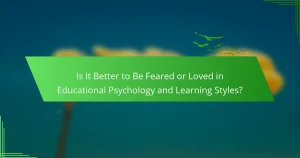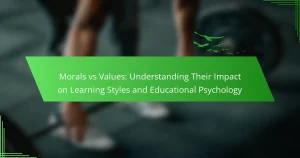Understanding learning styles is crucial for effective education, yet misconceptions abound. This article explores the principles of learning styles, the lack of scientific support for fixed preferences, and the importance of adaptable teaching methods. It also highlights the influence of cultural background and emotional intelligence on learning, while presenting effective strategies that engage multiple modalities for better retention and understanding.
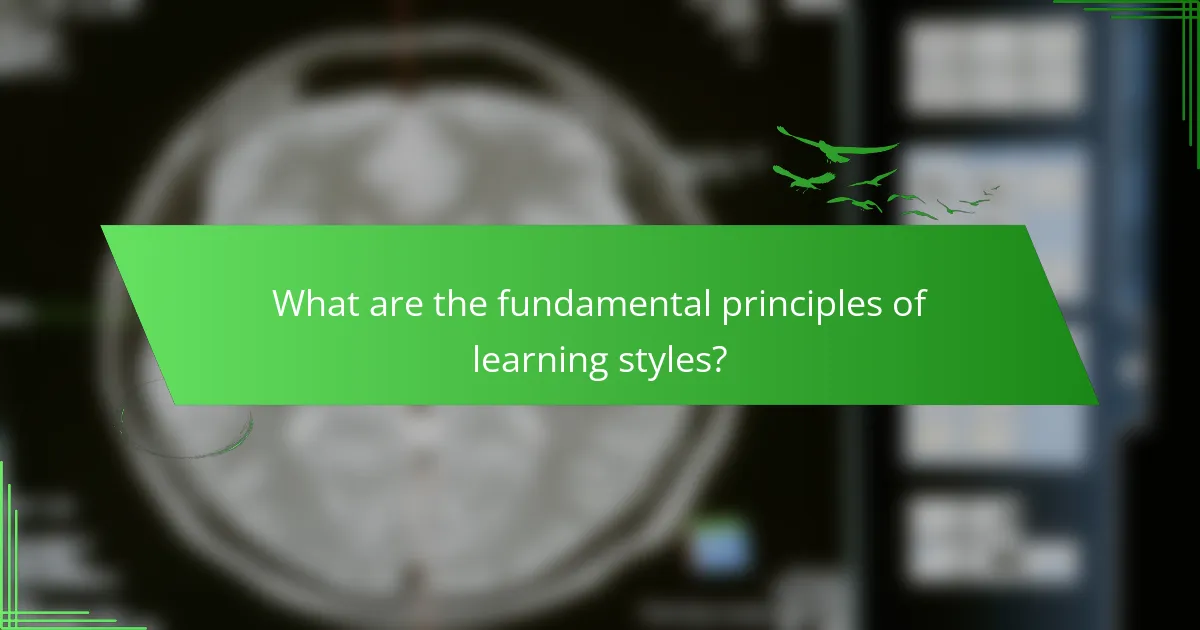
What are the fundamental principles of learning styles?
Learning styles emphasize that individuals have unique preferences for processing information. Key principles include the idea that people learn differently based on sensory modalities, such as visual, auditory, and kinesthetic. This concept, while popular, has faced scrutiny. Research indicates that adapting teaching methods to fit these styles may not significantly enhance learning outcomes. Instead, effective strategies focus on engaging multiple modalities, encouraging active participation, and fostering a growth mindset. Emphasizing a flexible approach can lead to better retention and understanding, regardless of individual learning style preferences.
How do learning styles influence educational outcomes?
Learning styles can significantly influence educational outcomes by shaping how students engage with material. Research indicates that tailoring teaching methods to individual learning styles can enhance comprehension and retention. For example, visual learners may benefit from diagrams, while auditory learners thrive with lectures. However, misconceptions exist; evidence suggests that focusing solely on learning styles may not lead to improved performance. Effective strategies include a balanced approach that incorporates various methods to cater to diverse learning preferences, fostering a more inclusive educational environment.
What are the most recognized models of learning styles?
The most recognized models of learning styles include the VARK model, the Multiple Intelligences theory, and the Kolb’s Experiential Learning Cycle. Each model identifies different preferences in how individuals absorb and process information.
The VARK model categorizes learners into Visual, Auditory, Reading/Writing, and Kinesthetic styles. The Multiple Intelligences theory, proposed by Howard Gardner, outlines eight distinct intelligences, emphasizing that people learn in varied ways. Kolb’s model focuses on a four-stage cycle of Concrete Experience, Reflective Observation, Abstract Conceptualization, and Active Experimentation, illustrating how learners engage with experiences.
These models, while popular, have faced criticism regarding their scientific validity. However, they provide valuable insights into diverse learning preferences, guiding educators in developing effective strategies tailored to individual needs.
What distinguishes the VARK model from others?
The VARK model emphasizes individual learning preferences through visual, auditory, reading/writing, and kinesthetic modalities, distinguishing it from other models that often generalize learning styles. Unlike broader approaches, VARK provides a structured framework for identifying specific learner needs. This model enables tailored educational strategies, enhancing engagement and retention. Research indicates that personalizing learning experiences can significantly improve outcomes.
How does Gardner’s Theory of Multiple Intelligences relate to learning styles?
Gardner’s Theory of Multiple Intelligences suggests that individuals possess various types of intelligence, which can influence their preferred learning styles. This theory highlights that learners may excel in different areas, such as linguistic, logical-mathematical, or interpersonal intelligence, shaping how they engage with information. Understanding these intelligences allows educators to tailor teaching strategies, enhancing learning effectiveness. For instance, a student strong in kinesthetic intelligence may benefit from hands-on activities, while one with strong linguistic intelligence may thrive in discussion-based learning. This approach addresses misconceptions that a single learning style fits all, promoting a more personalized educational experience.
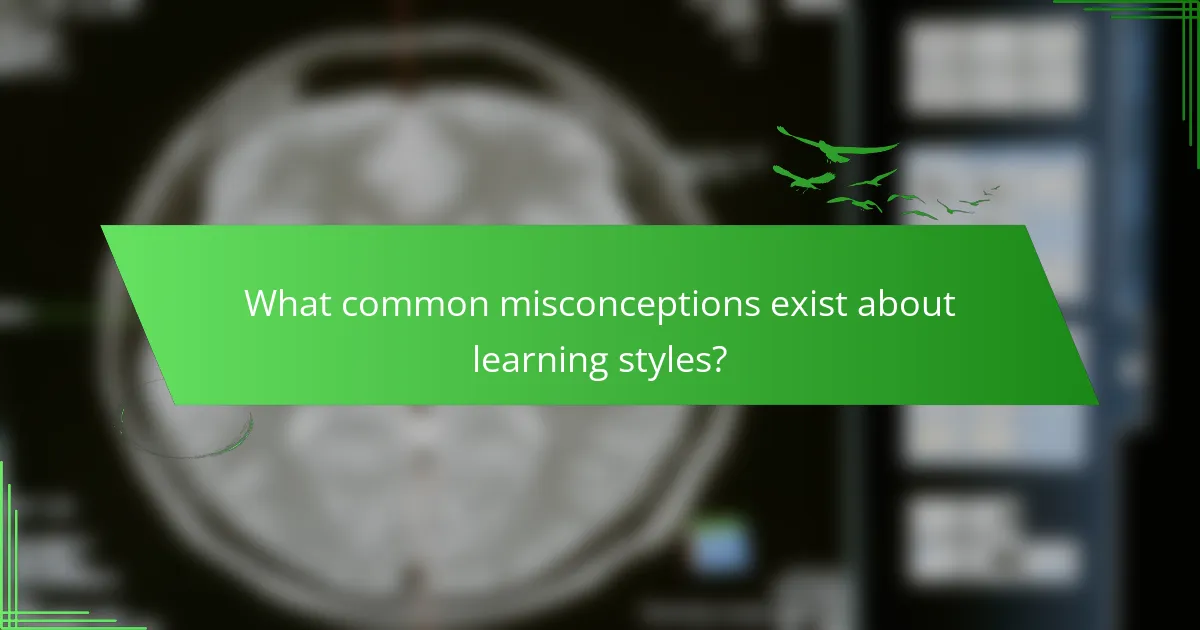
What common misconceptions exist about learning styles?
Many believe learning styles dictate how individuals learn best, but research shows this is a misconception. The idea that people have fixed learning styles, such as visual or auditory, lacks strong scientific support. Instead, effective learning often involves a mix of strategies tailored to the material and context. Studies indicate that teaching methods should focus on content rather than individual learning styles for better outcomes. Emphasizing flexibility and adaptability in learning approaches can lead to more effective education.
Why is the belief in fixed learning styles misleading?
The belief in fixed learning styles is misleading because it oversimplifies the complex nature of how individuals learn. Research indicates that learning is influenced by various factors like context, motivation, and prior knowledge rather than a fixed style. This misconception can hinder effective teaching strategies by promoting a one-size-fits-all approach. Instead, embracing a more flexible understanding of learning can lead to better educational outcomes.
How do misconceptions about learning styles affect teaching practices?
Misconceptions about learning styles can hinder effective teaching practices by promoting ineffective strategies. Educators may focus on tailoring instruction to perceived learning preferences rather than employing evidence-based methods. This can lead to a lack of engagement and hinder student performance. Research indicates that diverse teaching approaches benefit all learners, regardless of their supposed learning style. As a result, reliance on these misconceptions can limit the effectiveness of educational outcomes.
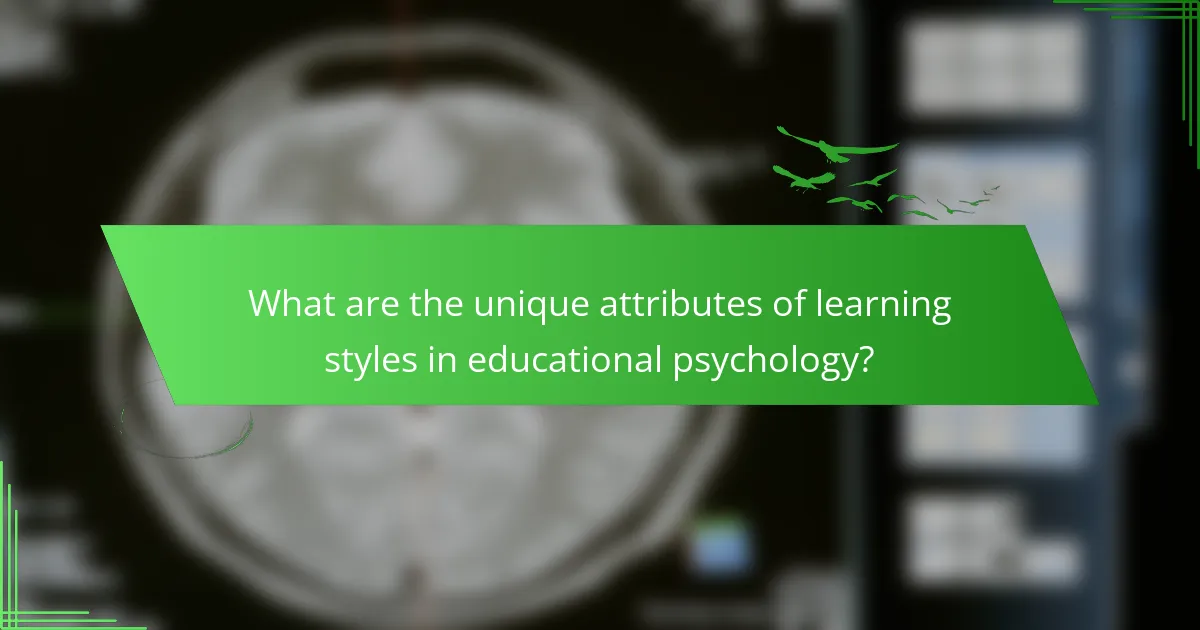
What are the unique attributes of learning styles in educational psychology?
Learning styles in educational psychology exhibit unique attributes that influence teaching effectiveness. These attributes include individual preferences for visual, auditory, or kinesthetic learning. Understanding these distinctions can enhance personalized educational strategies. Additionally, the misconception that learning styles dictate success persists, despite research indicating a more complex interplay of factors. Emphasizing adaptability in teaching methods remains crucial for addressing diverse learner needs.
How can understanding individual learning preferences enhance teaching effectiveness?
Understanding individual learning preferences can significantly enhance teaching effectiveness by tailoring instructional methods to meet diverse student needs. This personalized approach fosters engagement and retention, leading to improved academic outcomes. Research indicates that aligning teaching strategies with learning styles can increase motivation and participation. For instance, visual learners benefit from diagrams and videos, while auditory learners thrive on discussions and lectures. Recognizing these differences allows educators to create an inclusive environment that supports all learners, ultimately enhancing the overall educational experience.
What role do cultural factors play in learning styles?
Cultural factors significantly influence learning styles by shaping preferences and approaches to education. For instance, collectivist cultures may emphasize group learning, while individualistic cultures might favor independent study. These differences affect motivation, communication, and the interpretation of educational content. Understanding these cultural nuances allows educators to tailor their strategies, enhancing engagement and effectiveness.
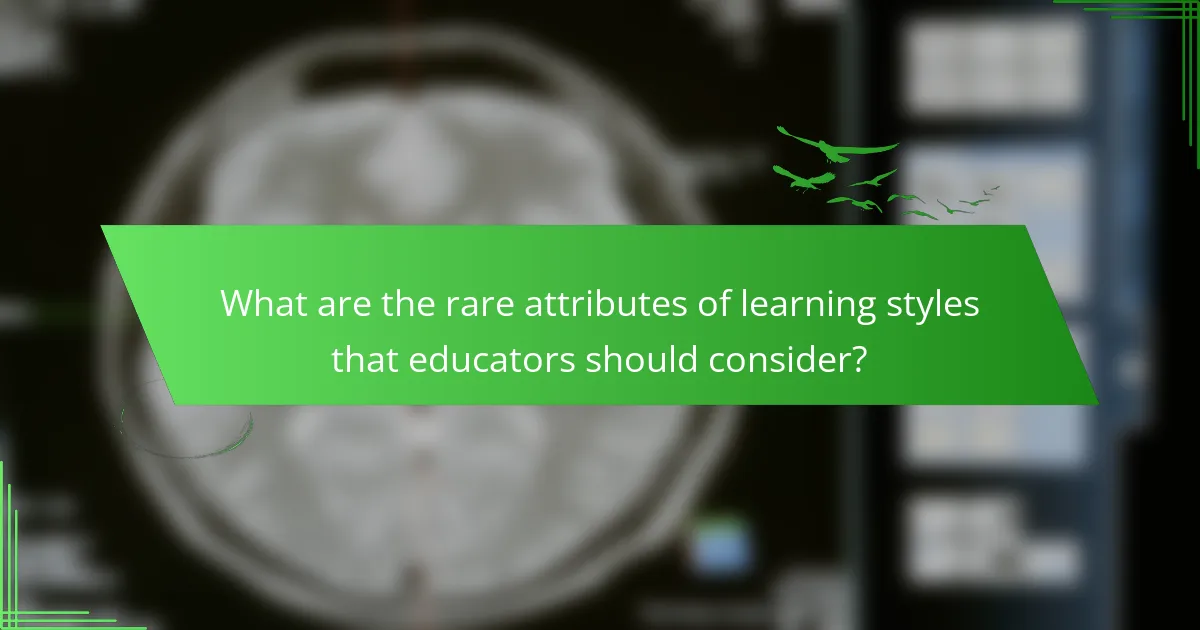
What are the rare attributes of learning styles that educators should consider?
Rare attributes of learning styles that educators should consider include the influence of cultural background, emotional intelligence, and neurodiversity. These factors can significantly impact how individuals process information and engage with learning environments. Understanding these rare attributes allows educators to tailor their approaches, fostering more inclusive and effective learning experiences. Additionally, recognizing the variability in sensory preferences and motivation levels among students can enhance instructional strategies.
How do neurodiversity and learning styles intersect?
Neurodiversity and learning styles intersect by acknowledging individual differences in cognitive processing. Neurodiverse individuals may benefit from tailored learning approaches that align with their unique cognitive strengths. For instance, visual learners often excel in environments that utilize imagery, while auditory learners thrive with verbal instructions. Understanding these intersections can enhance educational strategies, promoting effective engagement and retention. Research indicates that personalized learning environments improve outcomes for diverse learners, emphasizing the importance of adapting teaching methods to accommodate varying learning styles.
What emerging research challenges traditional views on learning styles?
Emerging research challenges traditional views on learning styles by highlighting the lack of empirical support for distinct learning preferences. Studies indicate that effective learning strategies are often universal rather than tailored to specific styles. For example, a meta-analysis found no significant correlation between learning styles and academic performance. This suggests that focusing on adaptable teaching methods, such as active engagement and feedback, may be more beneficial than adhering to rigid learning style categorizations.

How can educators effectively implement learning styles in the classroom?
Educators can effectively implement learning styles by adopting diverse teaching methods that cater to individual preferences. Integrating visual, auditory, and kinesthetic activities enhances engagement and retention.
Identifying students’ preferred learning styles through assessments allows educators to tailor lessons. For example, using multimedia presentations for visual learners and discussions for auditory learners can improve understanding.
Regular feedback from students helps refine teaching strategies. As a result, this adaptive approach fosters a more inclusive classroom environment. Research indicates that personalized learning can lead to higher achievement rates, emphasizing the importance of recognizing diverse learning styles.
What practical strategies can enhance learning for diverse styles?
Diverse learning styles can be enhanced through tailored strategies. Incorporating visual aids, interactive activities, and varied assessment methods addresses different preferences. For example, using diagrams benefits visual learners, while group discussions engage auditory learners. Additionally, providing options for project formats caters to kinesthetic learners, fostering deeper understanding and retention.
What are the best practices for assessing students’ learning preferences?
To assess students’ learning preferences effectively, utilize diverse assessment methods. Surveys, interviews, and observation can reveal individual learning styles. Incorporate activities that cater to visual, auditory, and kinesthetic learners. Analyze results to tailor teaching strategies that enhance engagement and retention. Regularly revisit assessments to accommodate evolving preferences.
How can formative assessments inform teaching methods?
Formative assessments significantly enhance teaching methods by providing real-time feedback on student understanding. These assessments allow educators to tailor instruction based on individual learning needs and styles. By identifying misconceptions early, teachers can adjust their strategies to ensure all students grasp key concepts. This adaptive approach fosters a more effective learning environment, ultimately improving student outcomes.
What common mistakes should educators avoid when applying learning styles?
Educators should avoid several common mistakes when applying learning styles. Focusing too rigidly on one style can limit student engagement and learning. Assuming all students fit neatly into specific categories ignores individual differences and preferences. Neglecting evidence-based strategies in favor of popular theories can hinder effective teaching. Overemphasizing learning styles may lead to a lack of diverse instructional methods, reducing overall effectiveness. Lastly, failing to assess student progress can prevent necessary adjustments to teaching approaches.
How can teachers adapt their methods to accommodate all learners?
Teachers can adapt their methods by employing diverse instructional strategies that cater to various learning styles. Incorporating visual aids, hands-on activities, and collaborative projects enhances engagement. Differentiated instruction allows for tailored approaches, addressing unique learner needs. Regular feedback and assessment ensure methods remain effective and responsive.
What expert insights can help refine the approach to learning styles?
Expert insights emphasize that learning styles are not fixed categories but rather fluid preferences that can adapt. Research indicates that effective strategies incorporate varied teaching methods to address diverse learner needs. Emphasizing the importance of metacognition, educators should encourage students to reflect on their learning processes. This approach fosters adaptability in learning, enhancing retention and application of knowledge. Additionally, integrating technology can provide personalized learning experiences, catering to individual preferences and promoting engagement.


